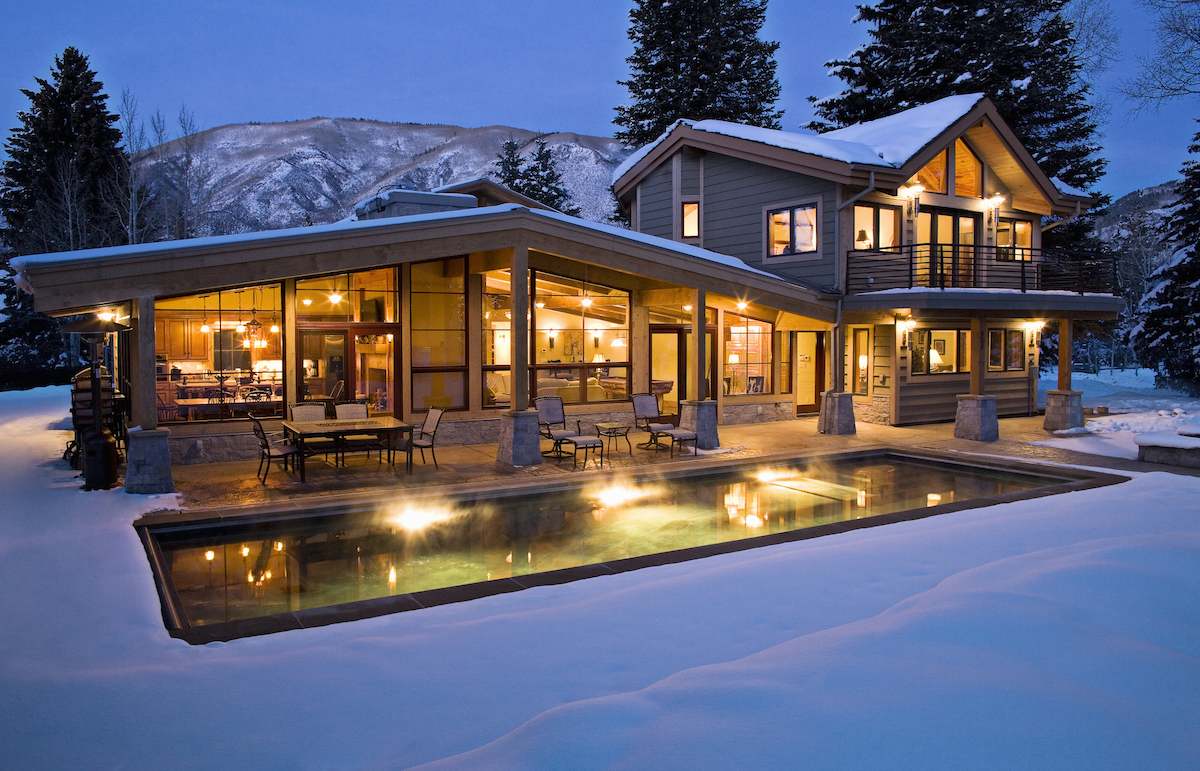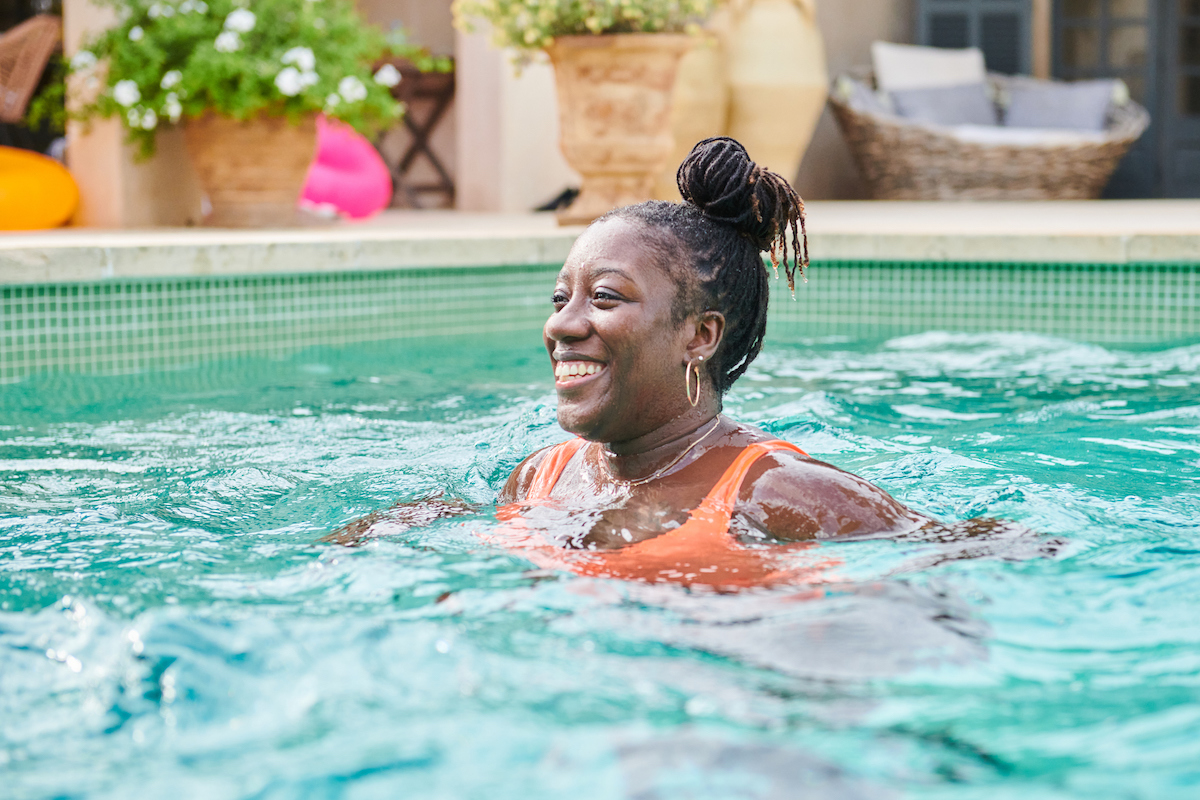

We may earn revenue from the products available on this page and participate in affiliate programs. Learn More ›
When you step into your pool on a hot summer day, you want to feel refreshed—not like you’re going for a soak in the tub or taking a dip in a frozen river. Using a pool thermometer can help determine the water’s temperature, but without knowing what the ideal pool temperature is, the reading will be about as useful as an educated guess.
Outside of comfort, another reason to maintain the “perfect” pool temperature for the season is for its optimal operation and maintenance. Pool owners can raise or lower the temperature of their water with strategic use of pool heaters, fresh water, and/or shade, but it all starts with determining what that magical temperature is for your pool in the first place.
The best pool temperature isn’t an exact number, but a range of temperatures.
What may be considered a good pool temperature can vary depending on the local climate, season, and the individual preferences of the swimmers, so it’s difficult to state an exact number as the best pool temperature for everyone. Instead, it’s better to think of the ideal pool water temperature as a range from 78 to 86 degrees Fahrenheit.
When the average pool temperature is kept within this range, the pool water is comfortable for moderate exercise and leisure activities. Additionally, maintaining this pool temperature can help prevent pool chemicals from evaporating quickly, while reducing the risk of algae blooms and bacteria growth, which can cause pool water to turn green.
How cold is too cold for swimming pool water?

When outdoor temperatures begin to plummet, it may be time to close the pool or invest in a pool heater. Water temperatures below 77 degrees Fahrenheit begin to affect your breathing, which is why Olympic swimming competitions require the water to be between 77 to 82 degrees. With this in mind, 70 degrees Fahrenheit should be the minimum swimming pool temperature for recreational swimming and leisure activities.
If you choose to keep the pool open despite the cold temperatures, there is a very real risk to the health of the swimmers. Be aware that between 60 to 70 degrees Fahrenheit it becomes difficult to hold your breath or control your breathing. As the temperatures drop to between 50 to 60 degrees Fahrenheit, people experience a total loss of breathing control and maximum cold shock. Below 40 degrees, water becomes so cold that it can feel like your skin is burning.
A heated pool or pool heater might be the best choice for winter swimming.
Since swimming in a freezing cold pool is neither safe nor comfortable, investing in a pool heater can be a great way to help control the water temperature. Rafi Friedman, president of Coastal Luxury Nocatee Pool Builders in Nocatee, Florida, notes that “a pool heater can extend your swimming season considerably, especially if you live in a colder climate. The issue is that they can be quite expensive to run, especially if you don’t invest in efficiency upgrades like a pool cover.”
The heated pool temperature can be adjusted by simply changing the setting on the pool heater thermostat to ensure the water remains at the most comfortable pool temperature for the season. During the warmer months, you can rely on alternative methods to heat the pool, but when fall and winter start to close in, having a pool heater is the best option for winter swimming.
How hot is too hot for swimming pool water?

Adding a solar pool heater can help keep the water warm without using a lot of electricity, but when the water is too hot, it can feel uncomfortable and may even lead to health issues as a result of overheating, like dizziness or nausea. Not only does the pool increase the temperature of your body, it also limits the effects of sweat, which would otherwise help to cool the body.
In some states there are regulations in place that require a pool to close if the water temperature exceeds 90 degrees Fahrenheit, while in other states the pool can stay open, but pregnant women, elderly persons, and anyone suffering from heart disease, diabetes, or blood pressure problems require permission from a doctor. Additionally, it’s worth noting that the water temperature for a spa or hot tub should not exceed 104 degrees Fahrenheit.
Shade, fresh water, and/or a reversible heat pump can cool down a pool.
A nice, warm pool can be great when the temperatures outside start to drop, but in the middle of summer it’s better to have cool pool water for a refreshing escape from the summer heat. Setting up trees, shrubs, and structures around the pool can provide shade to keep the pool water cool during the warmer months of the year. You can also install a reversible heat pump to control the temperature of the pool.
“Heat pump technology—the same kind that’s revolutionizing home HVAC technology—also works on water in swimming pools. You can use a modern pool heater/chiller to set your water to a particular temperature and keep it there,” Friedman says. However, if you don’t want to pay for a reversible heat pump, partially draining and refilling the pool with cold water can be a highly effective option, though you will need to rebalance the water chemistry.
Ultimately, the perfect pool temperature comes down to a matter of preference.

One person’s ideal pool temperature may be a tad too hot or cold for another pool owner’s liking, depending on their personal preference, type of pool, and how they use it. Generally, if a swimming pool is used for strenuous exercise like swimming laps, then the pool water temperature should range between 78 and 82 degrees Fahrenheit. A pool intended for recreation and leisure activities can be a little warmer, between 83 to 86 degrees Fahrenheit, since the swimmers won’t be working up as much of a sweat.
For therapy, stretching, or infant swimming lessons, it’s best to keep the pool between 88 to 90 degrees Fahrenheit. Warmer water helps with physical therapy and recovery, and it isn’t too cold for young children and infants who may not yet be able to regulate their internal temperatures effectively.
Final Thoughts
A swimming pool is great for exercise, games, splashing, jumping, sliding, diving, swimming, or just lounging around under the sun, but maintaining the ideal pool temperature can help improve the experience. If your pool is only used by one or two people, consider adjusting the temperature to best suit the most prevalent purpose of the pool, including exercise, recreation, or therapy.
However, when there are several swimmers of varying age and activity levels in the pool, then it’s recommended to choose a temperature between 78 to 86 degrees Fahrenheit based on the general consensus and preference of the swimmers. Consider investing in a reversible heat pump or a pool heater to control the temperature of the pool for the best results.
